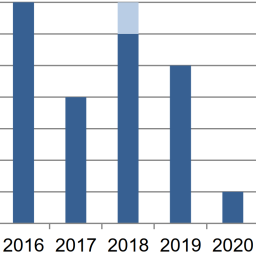Continuing animal tests on cosmetic ingredients for REACH in the EU
Main Article Content
Abstract
EU cosmetic ingredients are governed by two regulations that conflict. Regulation EC 1223/2009, the Cosmetic Regulation, bans in vivo (animal) testing for cosmetic product safety assessments, including both final products and ingredients. At the same time, the Registration, Evaluation, Authorization and Restriction of Chemicals (REACH) regulation can impose in vivo testing of those same ingredients under its chemical testing requirements. Here, we examined REACH dossiers for chemicals for which the only reported use is cosmetics to determine the extent of new in vivo testing caused by REACH. We found the REACH database has 3,206 chemical dossiers with cosmetics as a reported use. Of these, 419 report cosmetics as the only use, and 63 of these have in vivo tests completed after the Cosmetic Regulation ban on in vivo testing. Registrants largely used alternative, non-animal methods to evaluate ingredients for REACH, but some still conducted new in vivo tests to comply with REACH requirements for toxicity data and worker safety assessments. In some cases, ECHA, the agency that evaluates REACH dossiers, rejected registrants’ alternative methods as insufficient and required new in vivo tests. As ECHA continues to evaluate dossiers, more requests for in vivo tests are likely. REACH tests on cosmetic ingredients appear only as “industrial chemicals legislation” tests in EU reports. Given the importance to consumers and the cosmetic industry of having cosmetics free of animal testing, the public should be made aware of REACH testing until the conflict between the regulations is resolved.
Article Details

This work is licensed under a Creative Commons Attribution 4.0 International License.
Articles are distributed under the terms of the Creative Commons Attribution 4.0 International license (http://creativecommons.org/licenses/by/4.0/), which permits unrestricted use, distribution and reproduction in any medium, provided the original work is appropriately cited (CC-BY). Copyright on any article in ALTEX is retained by the author(s).
Adler, S., Basketter, D., Creton, S. et al. (2011). Alternative (non-animal) methods for cosmetics testing: current status and future prospects-2010. Arch Toxicol 85, 367-485. doi:10.1007/s00204-011-0693-2
Busquet, F., Kleensang, A., Rovida, C. et al. (2020). New European Union Statistics on Laboratory Animal Use – What Really Counts! ALTEX 37, 167-186. doi:10.14573/altex.2003241
Chesnut, M., Yamada, T., Adams, T. et al. (2018). Regulatory Acceptance of Read-Across: Report from an International Satellite Meeting at the 56th Annual Meeting of the Society of Toxicology. ALTEX 35, 413-419. doi:10.14573/altex.1805081
EC (2009). Regulation (EC) No 1223/2009 of the European Parliament and of the Council of 30 November 2009 on cosmetic products. Official Journal L342, 64. doi:10.3000/17252555.L_2009.342.eng
ECHA (2017). Guidance on Information Requirements and Chemical Safety Assessment Chapter R.7a: Endpoint specific guidance. ECHA-17-G-18-EN. doi:10.2823/337352
ECHA (2020). The use of alternatives to testing on animals for the REACH Regulation. Fourth report under Article 117(3) of the REACH Regulation. June 2020. ECHA-20-R-08-EN. doi:10.2823/092305
Gissi, A., Louekari, K., Hoffstadt, L. et al. (2017). Alternative acute oral toxicity assessment under REACH based on sub-acute toxicity values. ALTEX, 34(3) 353-361. doi:10.14573/altex.1609121
Hartung, T. (2008). Food for thought ... on alternative methods for cosmetics safety testing. ALTEX 25, 147-162. doi:10.14573/altex.2008.3.147
Hartung T. (2010). Food for thought… on alternative methods for chemical safety testing. ALTEX 27, 3-14. doi:10.14573/altex.2010.1.3
Hartung, T. and Rovida, C. (2009). Chemical regulators have overreached. Nature 460, 1080-1081. doi:10.1038/4601080a
Linkov, I., Massey, O., Keisler, J. et al. (2015). From “weight of evidence” to quantitative data integration using multicriteria decision analysis and Bayesian methods. ALTEX 32, 3-8. doi:10.14573/altex.1412231
Patlewicz, G., Ball, N., Becker, R. A. et al. (2014). Read-across approaches - misconceptions, promises and challenges ahead. ALTEX 31, 87-396. doi:10.14573/altex.1410071
Rovida, C. and Hartung, T. (2009). Re-evaluation of animal numbers and costs for in vivo tests to accomplish REACH legislation requirements for chemicals – A report by the transatlantic think tank for toxicology (t4). ALTEX 26, 187-208. doi:10.14573/altex.2009.3.187
Rovida, C., Barton-Maclaren, T., Benfenati, E. et al. (2020). Internationalisation of read-across as a validated new approach method (NAM) for regulatory toxicology. ALTEX 37, 579-606. doi:10.14573/altex.1912181
Rovida, C., Escher, S. E., Herzler, M. et al. (2021). NAM-supported read-across: From case studies to regulatory guidance in safety assessment. ALTEX 38, 140-150. doi:10.14573/altex.2010062


